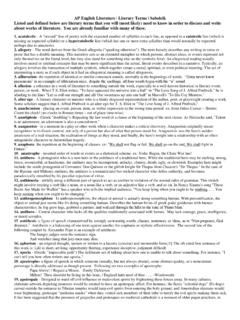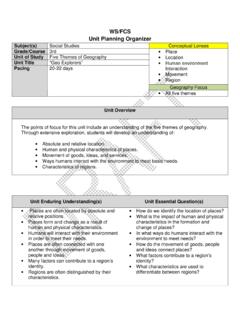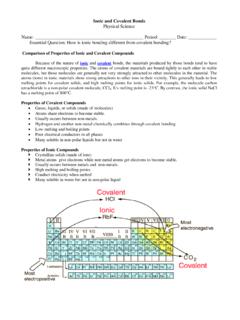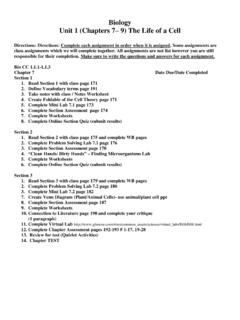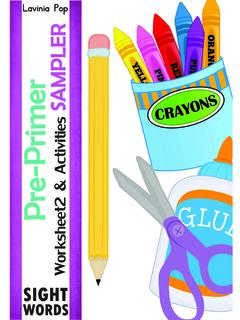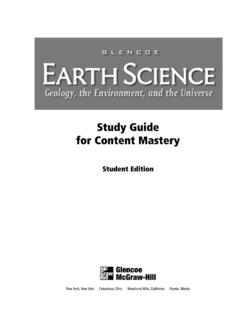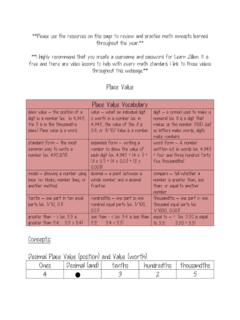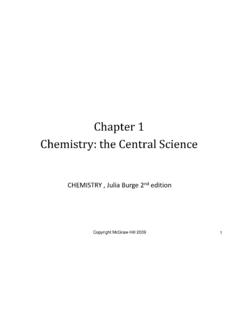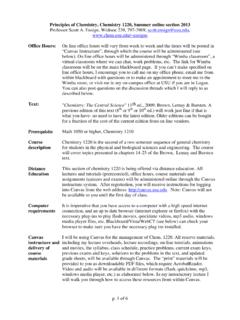Transcription of AP CHEMISTRY COURSE SYLLABUS - Winston-Salem/Forsyth ...
1 AP CHEMISTRY COURSE SYLLABUS Glenn High School Kernersville, NC Winston-Salem Forsyth County Schools CEEB 342025 Teacher: Ellen Nichols Hefner, National Board Certified CHEMISTRY Teacher 22 years teaching experience CHEMISTRY and Honors CHEMISTRY Teacher Textbook: CHEMISTRY : The central Science Brown / LeMay 12th edition(2012) Teacher resources: Test Prep series for AP Chemistry12th ed, Instructor Resource CD/DVD 12th ed, Test Generator 12th ed, new curriculum Student textbook: CHEMISTRY :The central Science Brown/LeMay 9th edition 2003 Supplementary materials and texts: 5 Steps to a 5 AP CHEMISTRY , 2014-2015 Edition (5 Steps to a 5 on the Advanced Placement Examinations Series) [Paperback] Richard H. Langley (Author), John Moore (Author) Laboratory Manual for CHEMISTRY the central Science A P CHEMISTRY Guided Inquiry Experiements Applying the Science Practices College Board 2013 Students Guide CHEMISTRY the central Science Hill 9th ed 2003 Guided Inquiry Experiments for General CHEMISTRY Konigsberg Kerner and Lamda 2008 Carolina Biological 16 kit AP CHEMISTRY Labs Various internet simulation sites, pHET and Gizmos, SAS Curriculum pathways.
2 Summer Assignment: Students were given a list of polyatomic ions to commit to memory, a set of solubility rules to learn, but not memorize, and two pages of general CHEMISTRY problems focusing on nomenclature and stoichiometry. Students are encouraged to complete the assignment before the first major test of the school year. COURSE Description and goals: AP CHEMISTRY class is designed to encourage the development of the fundamental concepts and principles of CHEMISTRY . There is an emphasis on inquiry and critical thinking skills, which include problem solving, mathematical reasoning, and experimental investigations. These investigations will be focused on the seven science practices listed below: Science Practice 1: The student can use representations and models to communicate scientific phenomena and solve scientific problems. Science Practice 2: The student can use mathematics appropriately. Science Practice 3: The student can engage in scientific questioning to extend thinking or to guide investigations within the context of the AP COURSE .
3 Science Practice 4: The student can plan and implement data collection strategies in relation to a particular scientific question. Science Practice 5: The student can perform data analysis and evaluation of evidence. Science Practice 6: The student can work with scientific explanations and theories. Science Practice 7: The student is able to connect and relate knowledge across various scales, concepts, and representations in and across domains. AP CHEMISTRY is built around six big ideas. The big ideas are: Big Idea 1: The chemical elements are fundamental building materials of matter, and all matter can be understood in terms of arrangements of atoms. These atoms retain their identity in chemical reactions. Big Idea 2: Chemical and physical properties of materials can be explained by the structure and the arrangement of atoms, ions, or molecules and the forces between them. Big Idea 3: Changes in matter involve the rearrangement and/or reorganization of atoms and/or the transfer of electrons.
4 Big Idea 4: Rates of chemical reactions are determined by details of the molecular collisions. Big Idea 5: The laws of thermodynamics describe the essential role of energy and explain and predict the direction of changes in matter. Big Idea 6: Any bond or intermolecular attraction that can be formed can be broken. These two processes are in a dynamic competition, sensitive to initial conditions and external perturbations. Laboratory work is an integral component of this COURSE and accounts for 25% of class time. Various technologies are integrated into the curriculum, including graphing calculators, probe ware, and use of various CHEMISTRY apparatus. In addition, students have access to the Internet. The class is designed to be a second year CHEMISTRY COURSE , and the equivalent of a yearlong introductory, college level general CHEMISTRY COURSE . The COURSE requires a working knowledge of CHEMISTRY , and second-year algebra.
5 As a result, students must complete Advanced CHEMISTRY and Algebra II the previous year. Students will be given a diagnostic at the beginning of the COURSE from the 5 steps to a 5 book to evaluate their knowledge retention of first year CHEMISTRY concepts. Students are expected to take the AP CHEMISTRY Exam at the end of this COURSE . Instruction is designed to provide students with a variety of appropriate learning opportunities through diverse teaching strategies. These include class discussions, collaborative pairs work, laboratories, Internet research and activities, hands on activities, and student prepared presentations. Goals 1. To foster scientific habits of mind and body, including objectivity, curiosity, and inventiveness. 2. To understand the fundamental concepts and principles of CHEMISTRY through the investigation of chemical phenomena, theories and experimental methods. 3. To develop problem solving skills and mathematical reasoning. 4. To understand the connections CHEMISTRY has to society, culture, technology and other sciences .
6 SUPPLIES: notebook, lab notebook (hard bound) quad ruled with graph paper, calculator, pencils, pens, highlighters, loose leaf paper GRADING SCALE: 100-93 A 92-85 B 84-77 C 76-70 D 0-69 F GRADING PROCEDURE: 1. MAJOR TESTS 40% 2. DAILY GRADES, quizzes, and problem sets 35% 3. LAB REPORTS 25 % COURSE Description/ SYLLABUS /Pacing Guide. Class is 90 min every other day for 1 year. Total of 82 class days before the AP exam. Duration Unit Concept(s) Chapters Big Idea Learning objectives Science Practices 2 classes matter/measurement 1,2 1,2 , , , , , , , , 1, 2, 3, 5, 6 1 class Nomenclature 2,25 1,2 , , , 1, 2, 3, 4, 5 2 classes atomic structure 2,3,6 1,3 , , , , , , , , , , , , 1, 2, 3, 4, 5, 6,7 3 classes periodic table 7 1 , , , , 3, 5, 6 5 classes Stoich 3 1,3 , , , , 1, 2, 3, 4, 5, 6 5 classes Reactions 4 1,3 , , , , , 1, 2, 3, 4, 5, 6, 7 Each Unit Concept is Described in more detail Below.
7 Matter/measurement separation of mixtures, elements, compounds, solutions, classification,physical and chemical properties, density Nomenclature of atoms ions molecules covalent ionic and organic(alkanes, alkenes, alkynes, and functional groups) atomic structure atomic theory, atoms ions isotopes percent composition average atomic mass law of conservation of mass wave nature of light quanta photons Bohr Model quantum numbers electron configurations orbital diagrams photoelectric effect mass spectrometry and Photon emission spectroscopy Columbs' Law periodic table trends effective nuclear charge groups properties Stoichiometry mole conversions, mole ratios, mass-mass stoichiometry, limiting reactants, percent yield, percent error Reactions types of reactions product predictions Solutions concentrations precipitation solubility colligative properties 5 classes Solutions 4,13 1,2,3 , , , , , 1, 2, 3, 4, 5, 6, 7 5 classes Gases 10 2,5 , , , , , , 1, 2 ,3, 5, 6, 7 5 classes Bonding 8,9 1, 2, 3, 5 , , , , , , , , 1, 3, 5, 6 ,7 5 classes IMFs, liquids and solids 11,23 2 , 5 , , , , , , , , , 1, 3, 5, 6, 7 8 classes Thermochemistry 5,19 3,5, 6.
8 , , , 1, 2, 3, 4, 6, 7 8 classes Kinetics 14 1,4 , , , 4,4, , , , , 1, 2, 3, 4, 5, 7, 6 10 classes Equilibrium 15,16,17 2, 3, 5, 6 through , , , , , , , , 1, 3, 4, 6, 5 10 classes acid/base 4,15,16,17 1,2, 3,5,6 through , , , , , , , , , 1, 3, 4, 6, 5 5 classes electrochemistry 4, 20 1,3 , , , , 2, 3, 5, 6 1 class organic CHEMISTRY 25 5 3, 7 nuclear CHEMISTRY 21 polymer CHEMISTRY 12 Gases gas laws kmt ideal gases Bonding ionic bonding, covalent bonding, polarity electronegativity, lewis structures, resonance bond length and order and strength molecular geometry hybridization imf, liquids and solids imfs, properties of liquids properties of solids changes of state, structure of solids, bonding in solids/metallic bonding Thermochemistry q, work, calorimetry, enthalpy, hess's law, spontaneity, entropy 2nd law of therm. Free energy Kinetics reaction rate, rate laws, concentration and rate, temp and rate and catalysts Equilibrium keq, le Chatlier's principle ksp acid/base pH, bronsted-lowry, ka, kb, kw, titrations, common ion effect buffers Electrochemistry redox reactions, electrolytic cells, voltaic cells, EMF, Organic nomenclature functional groups and biological compounds of interest Non lab inquiry based activities for each big idea.
9 ( SYLLABUS #1056705, AP at WFU June 2013) Possible Activities for Big Idea #1 (non-lab) 1. Students will graph and interpret several data sets on atomic properties (atomic radius, first ionization energy and electronegativity) in order to arrive at the periodic table from the jumps in the graphs Possible Activities for Big Idea #2 (non-lab) 1. Students will prepare models of the various electron pair arrangements, and complete a table which shows the Lewis structure, electron pair geometry, molecular structure, and use that information to predict the presence or absence of a dipole moment. Possible Activities for Big Idea #3 (non-lab) 1. Students will identify and balance chemical reactions using a variety of techniques on a series of quizzes from the reactions problem from previous AP exams. Old NIE s quizzes Possible Activities for Big Idea #4 (non-lab) 1. Students will demonstrate their knowledge of the determination of kinetics by displaying the solution to the following problem to the class.
10 The thermal decomposition of an organic nitrile produced the following data: t / (103 s) 0 [nitrile] / (mol L-1) Determine the order of the reaction and the rate constant. Possible Activities for Big Idea #5 (non-lab) 1. Students will explore an animation on heating and cooling curves ( , select heating curves) and answer a series of questions regarding their observations of particulate motion in the various phases. Possible Activities for Big Idea #6 (non-lab) 1. Students take the data from the spreadsheet Titrations on pH against added acid or base, and interpret the data in terms of the types of acid or base present, endpoints, the presence or absence of a buffer system, and appropriate indicators with justification based on the data. Possible Activities for Societal or Technological Impact of CHEMISTRY (lab or non-lab) 1. Students solve a stoichiometry problem on the amount of carbon dioxide produced in the burning of a tankful of gasoline (assumed to be octane) with information of the size of the gas tank of the vehicle, the density of octane ( g mL-1), and a variety of other conversion factors.
